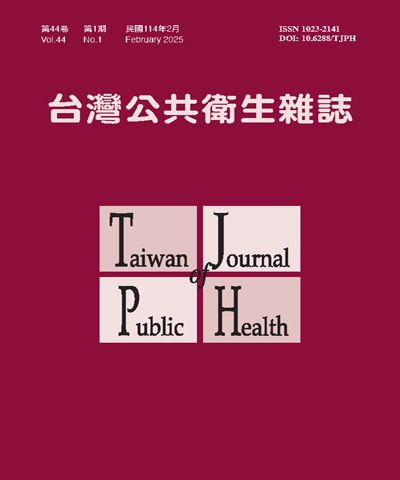
台灣公共衛生雜誌/Taiwan Journal of Public Health
臺灣公共衛生學會,正常發行
選擇卷期
- 期刊
歐美先進國家陸續採行公開揭露機制,以公開、分析,以及學習的態度處理醫療不良事件,期待降低醫療訴訟成本和不良事件再發生的可能性。美國是最早實施公開揭露機制的國家,澳洲則在整體政策發展的最為完整。因此,本文希望藉由耙梳美澳兩國公開揭露制度的發展歷史與現況,思索該制度對台灣建構醫療不良事件處理機制的啟發。從美澳兩國經驗來看,本文建議有二:第一,衛生主管機關應規劃執行大型醫療不良事件流行病學研究,促使醫療體系正視醫療傷害問題;第二,結合多元的社會行動者建立配套的社會立法和推動教育宣導,使台灣朝公開揭露醫療不良事件的目標邁進。
- 期刊
雖然利用生活習慣的改變是防治心血管疾病的基石,但是大多數人無法長期有效地持續進行行為矯正,來維持促進心血管健康。因此,利用包含aspirin、降血壓及降血脂藥物的混合藥劑“Polypill”來預防心血管疾病成為一個值得注意的預防策略。目前關於Polypill的藥效及不良反應之臨床試驗結果顯示出,Polypill是預防心血管疾病的良好策略,並且在醫師及病人對於使用Polypill的態度也顯示有一定可行性。然而,對於Polypill藥物中的組成成分、劑量及藥物的效果和安全性仍需更多的研究來評估,而且也需要進一步地研究Polypill是否能降低心血管疾病發病率及在發展中國家的成本效益分析。
- 期刊
目標:民眾普遍遇有剩餘藥品不知如何處理之現況,潛藏用藥安全、環境污染、及醫療資源浪費等問題,本研究針對民眾對於廢棄藥物認知及剩餘藥品原因進行分析及探討,據以參考改進及減少民眾家中剩餘之藥品。方法:在全市十二行政區內的社區藥局及醫院藥局設置「居家廢棄藥物檢收站」,由專業藥師協助市民進行居家廢棄藥物的分類與檢收,同時抽樣進行問卷調查。結果:於2010年4月1日至12月31日,共有2,012名民眾完成問卷調查,統計廢棄藥物主要來源是「看診領藥」(80.6%),產生剩藥的主要原因是「自覺病情或症狀改善」(23.7%)及忘記服藥(19.3%)。廢棄藥品主要種類為口服藥品(91.8%),依藥理分類區分則以「腸胃道用藥」(15.8%)及「心血管用藥」(13.4%)最多。結論:研究結果顯示大多數民眾服藥依順性仍有待改善,且多數藥品應為未服用放在家中放到過期才檢收。建議藥師對民眾多加宣導應依醫囑用藥,如為慢性病用藥不可自行停藥,非慢性病用藥若不須開藥可與醫師溝通,避免浪費健保資源。
- 期刊
目標:比較醫師與一般民眾在生命末期之醫療資源耗用是否有差異,並探索影響醫師生命末期醫療資源耗用之因素。彌補醫師病人生命末期醫療資源利用是否有差異之研究缺口。方法:利用1999至2003死因資料檔與全民健康保險資料庫中基本資料檔及住院檔加密後串聯,以醫師性別、死亡年齡、原死因別進行1:10配對抽樣選出對照組樣本(一般民眾),並利用複迴歸以及邏輯斯迴歸比較醫師與一般民眾死亡前六個月住院醫療耗用以及特殊醫療利用是否有差異。結果:醫師死亡前六個月住院總醫療費用、每次住院醫療費用、加護病房利用率、加護病房總住院天數等,均顯著皆高於一般民眾。結論:醫師在生命末期時其醫療費用顯著高於一般民眾。醫師成為病人時角色既獨特且具挑戰性,他們的醫師可能基於情誼給與同儕禮遇,在挽留同儕生命所做的決策可能與照護一般民眾有異。
- 期刊
目標:推估腦中風病人急性後期照護(Post-Acute Care,以下簡稱PAC)需要,並探討影響腦中風病人PAC需要之相關因素。方法:採回溯性世代研究法,自2005年健保申報資料擷取腦中風新個案為對象,以超長住院(≧29天)、再住院(1、14日內)、合併當次住院超長及再住院為概似指標(proxy)推估腦中風病人PAC需要。採用多層次分析(multilevel analysis)探討病人特質與醫院特質對PAC需要之影響因素。結果:腦中風病人以男性、年齡≧80歲、蜘蛛網膜下腔出血、有共病、入住復健科、有手術者,較有PAC需要;入住醫學中心者超長住院風險較高,入住地區醫院者較容易有再住院情形。腦中風病人約10.11(以當次住院超長估算)-23.13%(以合併當次住院超長及14日內再住院估算)有PAC需要;PAC人日占率為16.94-44.68%。實施PAC後平均每人約可節省急性醫療天數2.06-8.17天;估算病床之使用約可減少306-1,210張。結論:約10.11-23.13%腦中風病人可能需要PAC,衛生主管機關思考實施PAC支付/給付制度之可行性,以撙節急性醫療資源。
- 期刊
Objectives: The prevention of falls in elderly adults is an important issue. The aims of this study were to investigate the risk factors for falling and the effects of fall prevention programs for the high risk elderly in long-term care. Methods: There were two stages in this study from 2009/09 to 2010/2. In the first, we collected data on demographics, health status, history of falling, the geriatric depression scale, knowledge and behavior about preventing falls, and the mini-mental status examination (MMSE) with a structured questionnaire. The second stage was a pre-post study design with a 12 week fall prevention program that included health education and exercise. Results: The first stage was a cross-sectional study design and involved a sample of 286 aged 65 and older, high risk elderly. Of these, 33.9% had fallen at least one or more times in the past year. The main risk factors were use of analgesics (OR=3.75, 95%C.I=1.40-10.01), use of hypnotics (OR=2.71, 95%C.I=1.32-5.57), no regular exercise (OR=2.19, 95%C.I=1.00-4.68) and avoidance of activity due to a fear of falling (OR=2.61, 95%C.I=1.39-4.91). In the second stage, 69 subjects completed the 12-week fall prevention program which focused on reduction of the incidence and fear of falling, improvement in health-related quality of life, ability to balance, and strengthening the lower-extremities. Conclusions: The fall prevention program improved fear of falling, quality of life, and partial body function among the elderly in long-term care institutions. This study offers our suggestions and clinical interventions as the basis for future studies with more subjects in other long-term care institutions.
- 期刊
Objectives: To investigate the concentration and distribution of airborne microbes at the Taipei International Flora Exposition. Methods: Airborne bacteria and fungi were quantified and categorized at indoor pavilions (Expo Dome and Pavilion of the Future) and outdoor locations (Floral Rainbows, Flower Landscape and Flower Base under a Tree). Results: The highest fungal concentration (394.9±326.9 cfu/m3) was found at Pavilion of the Future. This was significantly greater than that at the Expo Dome (177.6±74.6 cfu/m3) (p<0.05). Seven percent of the samples obtained from Pavilion of the Future exceeded the level of fungi (1000 cfu/m3) suggested by the Taiwan EPA for good indoor air quality. The highest bacterial concentration was found at Flower Base under a Tree (340.3±187.6 cfu/m3), followed by the Expo Dome (299.6±171.5 cfu/m3). Bacterial concentration at the Expo Dome was significantly higher than that at Floral Rainbows (149.7±74.7 cfu/m3) (p<0.05). Gram positive rods (67.5%~82.7%) were dominant at every site studied, followed by Gram positive cocci (7.9%~14.6%). The most identified fungi were Cladosporium (68.6%~73.7%), followed by Penicillium (41.3%~27.7%). Conclusions: Our results demonstrated no significant increase in the level of airborne microbes at the Flora Exposition. Only a few samples exceeded the level of airborne microbes suggested by the Taiwan EPA for good air quality. This finding supports the observation that airborne microbes may be efficiently controlled through proper air conditioning and environmental management.
- 期刊
Objectives: Children's growth and intellectual development are affected by low-level lead exposure. The aims of this research were to measure the concentration of lead in the blood of the kindergarten children in Taiwan and to explore the relevant determinants in order to prevent future lead exposure. Methods: Random sampling was done at various administrative levels such as district, city, town, and village. Kindergartens from administrative areas that were randomly selected were then invited to participate in this project between April and October 2011. A total of 934 children from the participating kindergartens in the selected areas took part in this study after their parents signed a statement of consent. Blood lead level was determined with inductively coupled plasma. Results: The geometric mean level of lead in the blood of kindergarten children was 1.86 μg/dL (geometric standard deviation =1.55). The percentage of blood lead concentrations exceeding 4 μg/dL was 3.7%. In terms of geographical areas, subjects from the off-shore islands had the highest geometric mean blood lead concentration (2.59 μg/dL), while those in northern Taiwan had the lowest (1.53 μg/dL). Among the counties, children from Kinmen (2.80 μg/dL) and Changhua (2.53 μg/dL) presented with the highest blood lead levels while those in Taoyuan (1.28 μg/dL) and Hsinchu (1.32 μg/dL) had the lowest. Blood lead concentration was negatively correlated with household income and level of parental educational (p < 0.0001). Children whose fathers worked in the industries of Agriculture, Forestry and Fisheries tended to have higher blood lead levels (> 2.20 μg/dL). Conclusions: There is an international consensus to further lower the safety threshold for children's blood lead levels since damage to the brain and nervous system has been reported with blood lead levels less than 10μg/dL. Therefore, even though the blood lead levels of kindergarten children have generally been reduced to 1~3 μg/dL in Taiwan, a referential threshold of 4 μg/dL was suggested in order to enhance the prevention of lead exposure for people at high risk, with efforts on eliminating health disparities and inegualities in the general population.

